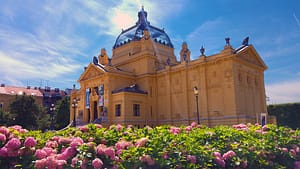What makes Zagreb completely different that the other European metropolises is its charm and directness, as well as an excellent geographic position at the junction of important roads between the Adriatic coast and Central Europe.
Although it has all the characteristics of a Central European city, Zagreb’s charm comes from its coffee houses and outdoor garden patios typical of the Mediterranean lifestyle. Thanks to the modern motorways excellently connecting it with the coast, Zagreb is in a way a seaside city as well. The capital city of Croatia on the banks of Sava River, 170 kilometers from the Adriatic Sea, is situated at 122 meters above sea level. It has a continental climate with an average temperature of 20 degrees in summer and 1 degree Celsius in winter. According to the last census (2001), 780 thousand people live in Zagreb, but it has a population of over a million with the ring around it that has absorbed many surrounding areas.
Zagreb is a business and scientific hub, a university center, a city of culture, art and entertainment. Many reputable scientists, artists and athletes originate from and work in Zagreb. Zagreb offers its guests the baroque ambient of the Uptown (Gornji Grad), picturesque outdoor marketplaces, various shops in Tkalciceva Street and a wide range of craftsmen’s products, and a delicious domestic cuisine. Zagreb is a city of green parks and promenades, with numerous excursion spots in its beautiful surroundings. Despite the rapid development of the economy and transport, it has preserved is distinctive beauty and a relaxed feeling, making it a city truly tailored to man.
The historical treasure is kept and exhibited in Zagreb’s museums. In addition to items associated with the city’s history, Zagreb’s museums and art collections feature exhibits from all over the world of a remarkable historical and artistic value. The Zagreb mummy with the longest Etruscan inscription in the world and the remains of the Krapina Neanderthal (homo Krapinensis) are special rarities.
The Technical Museum holds the oldest preserved machine in the area, dating back to 1830, which still works. The Mimara Museum keeps the Wiltrud and Ante Topic Mimara donations and the permanent layout features over 1,500 exhibits from the prehistoric times to the 20th century. HAZU’s (Croatian Academy of Science and Art) Strossmayer Gallery of Old Masters has a permanent layout of European painting from the 14th century to the 19th century, while the Meštrovic Studio holds sculptures, drawings, litographic maps and other items donated to Croatia by the great artist. The Klovicevi Dvori Gallery regularly puts on exhibitions of globally renowned artists. The significance of the gallery named after a renaissance master of miniatures is confirmed by the fact that it featured a retrospective of the greatest masters of German expressionism entitled “The Quiet Rebellion” in late 2008 and early 2009 (www.galerijaklovic.hr).

